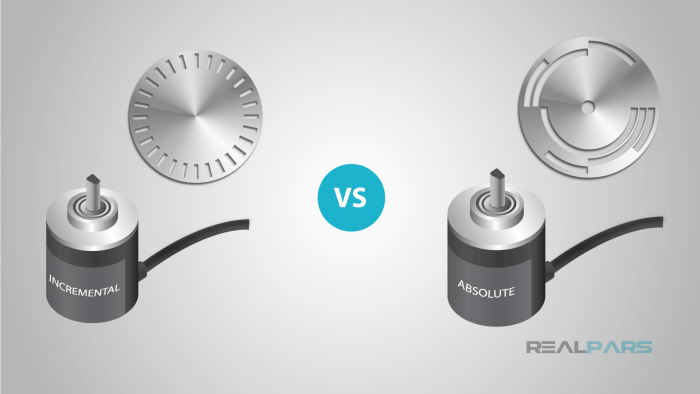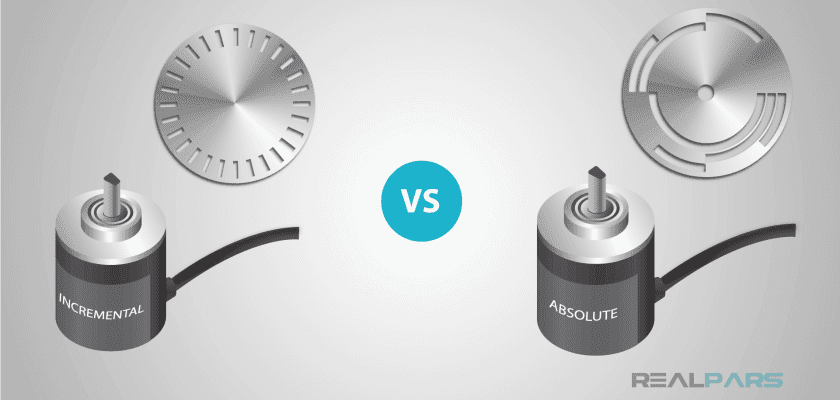An absolute encoder can produce a constant value, while an incremental encoder can only make each point on a spectrum. For example, a final joystick position would be zero degrees and each increment in the complete circle would be one degree. In contrast, an incremental controller might have “dead zones” that are not usable for motion, such as grayscale values of 0-255. The relative position on the controller might range from 1-10, with 0 being the center or neutral position. This article explains the difference between absolute and incremental encoders.

Image Source: Real Pars
What is an Absolute Encoder?
An absolute encoder is a device that produces a constant value instead of an incremental value. It has a unique number that represents its position on a scale so that it can be easily interfaced with other devices, such as motors or displays. An absolute encoder uses one of two methods for measuring position:
- a) A potentiometer (variable resistor) — this method uses resistance or voltage to measure degrees.
- b) Laser — this method involves scanning the surface of an object and then measuring the time it takes to return a reflected signal.
Absolute encoders have the following advantages over incremental encoders:
- No position control circuitry is required. An ADC or DAC (Analog-Digital Converter) IC is the only electronics required.
- A higher resolution allows for a finer level of control. For example, if you had a joystick partitioned into 64 zones (some incremental controllers have 32 zones), with an absolute encoder, you would have values from 1-64 instead of 0-31 or 1-32.
- Allows for easy interface with other devices.
- Stronger signal. The higher the resolution, the more stable the output signal is.
What is an Incremental Encoder?
An incremental encoder operates by sharing a variable resistor with a potentiometer (variable resistor). The purpose of this variable resistor is to produce each increment on a scale from 0-10, 00-09, etc. The dials on some controllers are classified as incremental because they use a variable resistor that can change its resistance alone to move a corresponding increment on the dial. The following are some examples of incremental encoders:
- Analog sticks or other dials that can be rotated or toggled between different values. The variable resistor changes the resistance within a small range for each increment.
- Piezo speaker clusters are mounted in front of the moving object. These clusters differ by the configuration of their parts and what they say when they produce sound. You would use a piezo speaker cluster to indicate when a user has moved their head in front of the sound source.
3. Absolute Encoders and Analog Controls
Some controllers use a potentiometer (variable resistor) to measure their position. This type of controller is one example of an absolute encoder. However, their design causes the value they produce to vary by a certain amount based on the position of their dial or object. For example, a joystick might pay deals between 1-10, but the value it produces changes depending on which direction it is rotated. This kind of controller does not allow for absolute movements and should be classified as an incremental controller instead.
4. Absolute Encoders and Analog Controls
Some controllers have analog controls or dials that can be rotated to change the value they produce. These controllers are classified as absolute because they provide a constant value instead of an incremental value. A common example is a potentiometer (variable resistor) encoder and a joystick. These controllers do not need to be used along with an additional switch or sensor just because it provides extra functionality and can act as both, either, or neither of the two types of encoders you might find in your controller. However, remember that these two controllers should always be used at different times.
5. Absolute Encoders and Digital Controls
Suppose you wish to use a potentiometer (variable resistor) encoder that produces an analog value but wants to interface it with a digital system, such as an MCU or microcontroller. In that case, you will need to use a changing resistor or comparator. A changing resistor is a voltage divider made up of two resistors, and it can be used as an absolute encoder by constructing an analog circuit around it. The resistance of the voltage divider changes based on the position of the encoder dial. To convert this signal into digital values for their final output, you will use a DAC (Analog-Digital Converter) IC. The DAC will convert the analog signal into a digital value and send it to the production of your project.
6. Absolute Encoders and Digital Controls
Suppose you wish to use a potentiometer (variable resistor) encoder that produces an analog value but wants to interface it with a digital system, such as an MCU or microcontroller. In that case, you will need to use a changing resistor or comparator. A changing resistor is a voltage divider made up of two resistors, and it can be used as an absolute encoder by constructing an analog circuit around it. The resistance of the voltage divider changes based on the position of the encoder dial. To convert this signal into digital values for their final output, you will use a DAC (Analog-Digital Converter) IC. The DAC will convert the analog signal into a digital value and send it to the production of your project.
7. Absolute Encoders and Analog Controls
Some controllers have analog controls or dials that can be rotated to change the value they produce. These controllers are classified as absolute because they provide a constant value instead of an incremental value. A common example is a potentiometer (variable resistor) encoder and a joystick. These controllers do not need to be used along with an additional switch or sensor just because it provides extra functionality and can act as both, either, or neither of the two types of encoders you might find in your controller. However, remember that these two controllers should always be used at different times.

